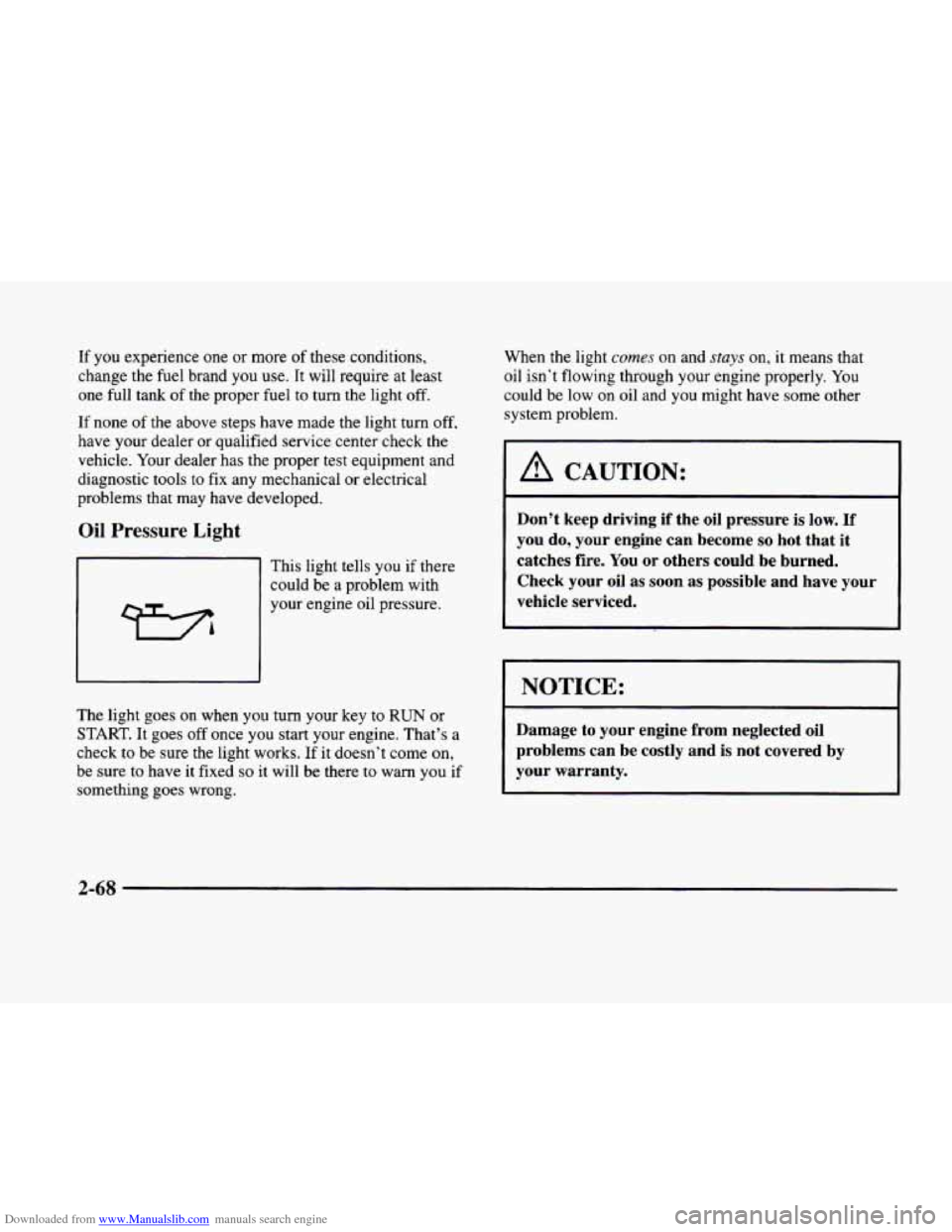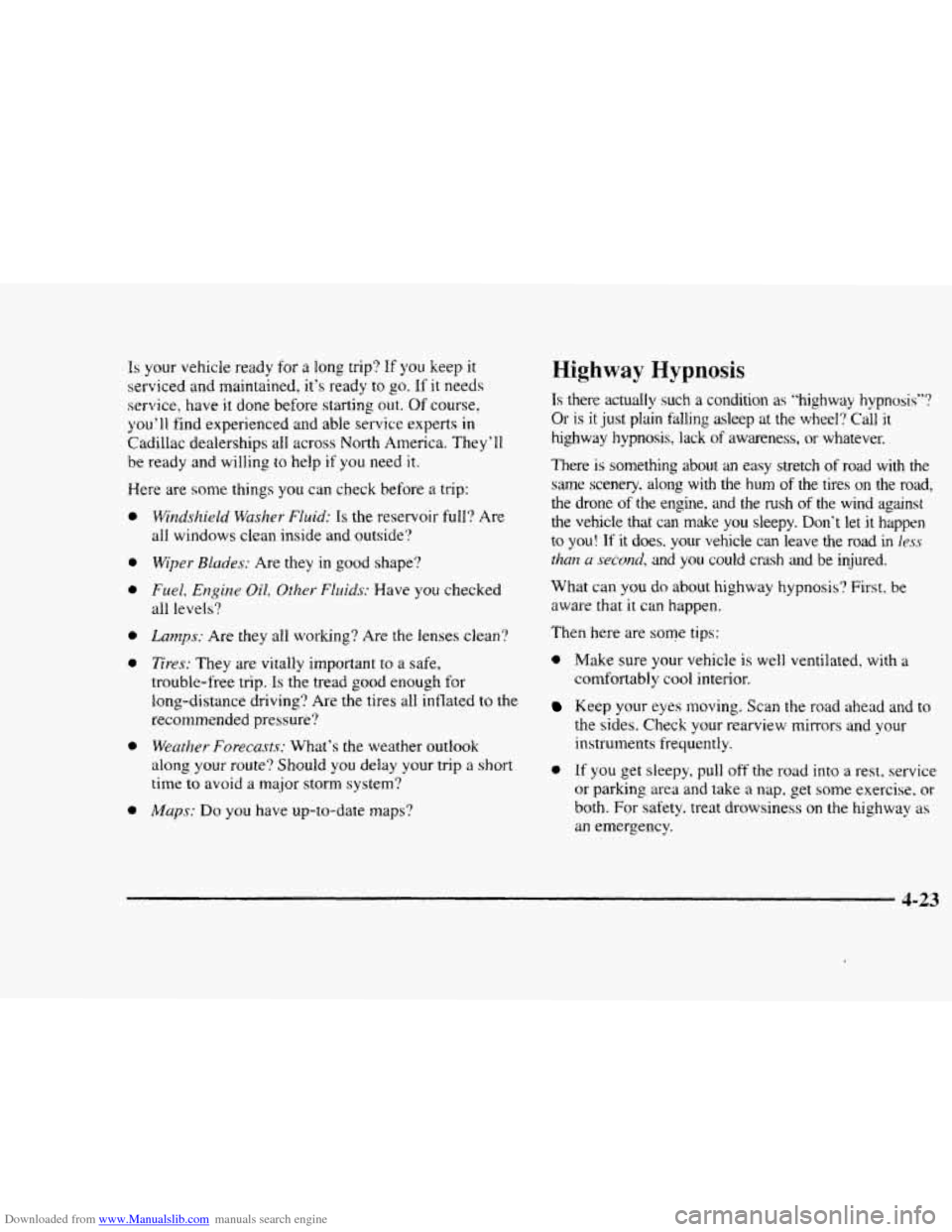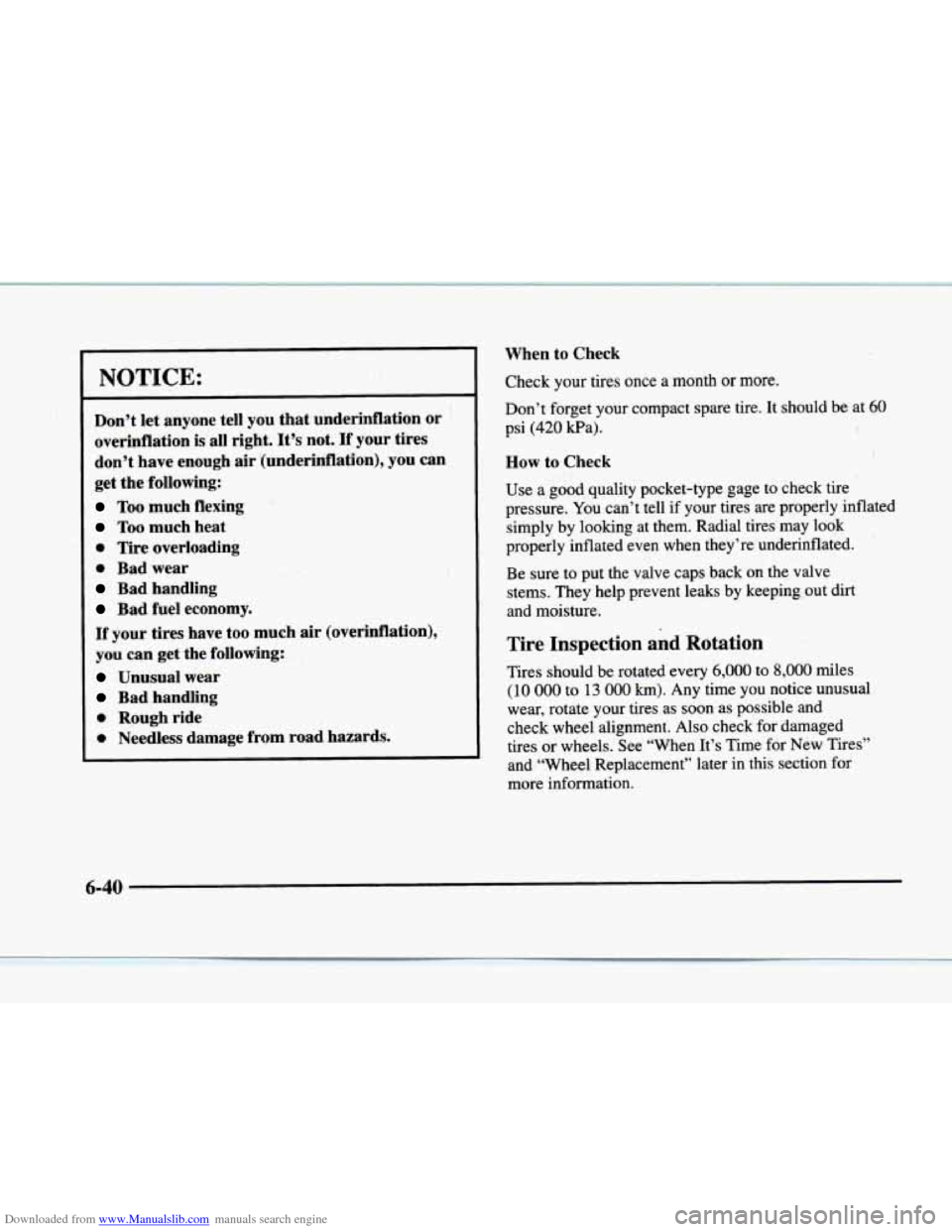1998 CADILLAC ELDORADO fuel pressure
[x] Cancel search: fuel pressurePage 19 of 380

Downloaded from www.Manualslib.com manuals search engine For example, these
symbols
are used on an
original battery:
POSSIBLE A
CAUTION
INJURY
PROTECT EYES BY
SHIELDING
CAUSTIC
ACID COULD
BAlTERY
CAUSE
BURNS
SPARK
OR ,\I/,
COULD FLAME
EXPLODE BAllERY
These symbols
are important
for you and
your passengers
whenever your
vehicle
is
driven:
DOOR LOCK
UNLOCK
FASTEN SEAT
BELTS
These symbols
have
to do with
your lamps:
SIGNALS e
TURN
FOG LAMPS
# 0
These symbols
are
on some of
your controls:
WINDSHIELD
WIPER
WINDSHIELD DEFROSTER
WINDOW
DEFOGGER
These symbols
are used on
warning and
indicator lights:
COOLANT -
TEMP -
CHARGING I-1
BAlTERY
SYSTEM
BRAKE
(0)
COOLANT a
ENGINE OIL e,
PRESSURE
ANTI-LOCK
(@)
BRAKES
Here are some
other symbols
you may see:
FUSE
t
LIGHTER
HORN tcr
SPEAKER
cr
FUEL p3
Page 138 of 380

Downloaded from www.Manualslib.com manuals search engine If you experience one or more of these conditions,
change the fuel brand
you use. It will require at least
one full tank
of the proper fuel to turn the light off.
If none of the above steps have made the light turn off,
have your dealer or qualified service center check the
vehicle. Your dealer has the proper test equipment and
diagnostic tools to fix any mechanical
or electrical
problems that may have developed.
Oil Pressure Light
This light tells you if there
could be a problem with
your engine oil pressure.
The light goes
on when you turn your key to RUN or
START. It goes off once you start your engine. That’s a
check
to be sure the light works. If it doesn’t come on,
be sure to have it fixed so it will be there to warn you if
something goes wrong. When the light
cumes on
and stays on, it means that
oil isn’t flowing through your engine properly. You
could
be low on oil and you might have some other
system problem.
1 A CAUTION:
Don’t keep driving if the oil pressure is low. If
you do, your engine can become so hot that it
catches fire. You
or others could be burned.
Check your oil as soon as possible and have your
vehicle serviced.
I NOTICE: 1
Damage to your engine from neglected oil
problems can be costly and is not covered by
your warranty.
2-68
Page 221 of 380

Downloaded from www.Manualslib.com manuals search engine Is your vehicle ready for a long trip? If you keep it
serviced and maintained. it's ready to go. If it needs
service, have
it done before starting out. Of course.
you'll find experienced and able service experts in
Cadillac dealerships ail across North America. They'll
be ready and willing to help if you need it.
Here are some things you can check before a trip:
0
0
0
0
a
0
a
Windshield Washer Fluid: Is the reservoir full? Are
all windows clean inside and outside'?
Wiper Blcrdes: Are they in good shape?
Fuel, Engine Oil, Other Fluids: Have you checked
all levels?
Lamps: Are they all working? Are the lenses clean'?
Tires: They are vitally important to a safe,
trouble-free trip. Is the tread good enough for
long-distance driving? Are the tires all inflated to the
recommended pressure'?
Wenfher- Forecusts: What's the weather outlook
along
your route? Should you delay your trip a short
time to avoid a major storm system?
Mups: Do you have up-to-date maps?
Highway Hypnosis
Is there actually such a condition as "highway hypnosis"?
Or
is it just plain t'alling asleep at the wheel? Cali it
highway hypnosis, lack of awareness, or whatever.
There
is something about an easy stretch of road with the
same scenery, along with the hum of the tires on the road,
the drone of the engine. and the rush of the wind against
the vehicle thdt can make you sleepy. Don't let it happen
to
you! If it does. your vehicle can leave the road in less
th~~ a second, and you could crash and be injured.
What can you
do about highway hypnosis? First, be
aware that
it can happen.
Then here are some tips:
0 Make sure your vehicle is well ventilated, with a
comfortabiy cool interior.
Keep your eyes moving. Scan the road ahead and to
the sides.
Check your rearview mirrors and your
instruments frequently.
a If you get sleepy, pull off the road into a rest, service
or parking
area and take a nap, get some exercise. or
both. For safety, treat drowsiness on the highway as
an emergency.
4-23
Page 228 of 380

Downloaded from www.Manualslib.com manuals search engine Loading Your Vehicle
[@ OCCUPANTS VEHICLE CAP, WT.
TIRE-LOADING INFORMATION
KG LBS. FRT. CTR. RR. TOTAL
MAX. LOADING
& GVWR SAME AS VEHICLE
CAPACITY WEIGHT XXX COLD TIRE
TIRE
SIZE SPEED PRESSURE
RTG PSL’KPa
FRT.
RR.
SPA.
IF TIRES ARE HOT, ADD 4PS1!28KPa
SEE OWNER‘S MANUAL FOR ADDITlONAL
\INFORMATION
Two labels on your vehicle show how much weight it
may properly carry. The Tire-Loading Information label
found
on the driver’s door tells you the proper size,
speed rating and recommended inflation pressures for
the tires on your vehicle. It also gives you important
information about
the number of people that can be in
your vehicle and the total weight that
you can carry.
This weight is called the Vehicle Capacity Weight and
includes the weight
of all occupants, cargo and all
options not installed in the factory.
MFD BY GENERAL MOTORS CORP
DATE GVWR
GAWR FRT GAWR RR
THIS VEHICLE CONFORMS TO ALL APPLI-
CABLE US. FEDERAL MOTOR VEHICLE
SAFETY,
BUMPER, AND THEFT PREVENTION
STANDARDS
IN EFFECT ON THE DATE OF
MANUFACTURE SHOWN ABOVE.
The other label is the Certification label. found on the
rear edge
of the drives’s door. It tells you the gross
weight capacity
of your vehicle, called the GVWR
(Gross Vehicle Weight Rating). The GVWR includes
the weight
of the vehicle, all occupants, fuel and cargo.
Never exceed
the GVWR for your vehicle, or the Gross
Axle Weight Rating (GAWR)
for either the front or
rear axle.
If you do have a heavy load, you should spread it out.
Don’t carry more than
176 lbs. (80 kg) in your trunk.
Page 320 of 380

Downloaded from www.Manualslib.com manuals search engine NOTICE:
Don’t let anyone tell you that underinflation or
overinflation
is all right. It’s not. If your tires
don’t have enough air (underinflation), you can
get
the following:
Too much flexing
Too much heat
0 Tire overloading
0 Bad wear
Bad handling
Bad fuel economy.
If your tires have too much air (overinflation),
you can get the following:
Unusual wear
Bad handling
0 Rough ride
0 Needless damage from road hazards. When
to Check
Check your tires once a month or more.
Don’t forget your compact spare tire. It should be at
60
psi (420 Wa).
How to Check
Use a good quality pocket-type gage to check tire
pressure.
You can’t tell if your tires are properly inflated
simply by looking
at them. Radial tires may look
properly inflated even when they’re underinflated.
Be sure to put the valve caps back on the valve
stems. They help prevent leaks by keeping out dirt
and moisture.
Tire Inspection and Rotation
Tires should be rotated every 6,000 to 8,000 miles
( 10 000 to 13 000 km). Any time you notice unusual
wear, rotate your tires as soon as possible and
check wheel alignment. Also check for damaged
tires or wheels. See “When It’s Time for New Tires”
and “Wheel Replacement” later in this section for
more information.
a
Page 341 of 380

Downloaded from www.Manualslib.com manuals search engine Fuse
WIPERS A/C COMP
PCM
(BAT)*
PARWREV
ECS*
PCM (IGN)*
Usage
Accessory Relay, Wiper Switch
AC Compressor Relay, Cooling Fan
Relays
I, 2.3, Compressor Clutch
PCM
TCC and Exterior Travel Brake
Switch, Reverse Relay, Right and
Left Back-up Lamps,
Electrochromic Mirror
(in Header).
Park Relay, Brake Transaxle- Shift Interlock (BTSI) Switch,
BTSI, PZM
Transaxle Shift Solenoids, Mass
Aifflow, Canister Purge, PCM,
Linear Exhaust Gas Recirculation
(EGR), Front Ignition-
1 Relay,
Torque Converter
Powertrain Control
Module (PCM)
Fuse
DIS *
CRUISE
INJ*
INJ*
Usage
Electronic Ignition Control Module
Stepper Motor Cruise Control,
Power Steering Pressure Switch,
Low Refrigerant Pressure Cutoff
Switch, Park
Relay
Injectors 1,4. 6, 7
Injectors 2. 3. 5, 8
FUEL PUMP* PCM, Fuel Pump Relay, Fuel Pump
OXY SEN1 * Oxygen Sensor Front, CAT Front
Oxygen Sensor
OXY SEN2* *Oxygen Sensor Rear.
Catalytic Converter (CAT)
Rear Oxygen Sensor
* Do not alter OBD I1 related fuses or circuit breakers.
6-61